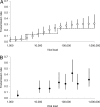Variation in HIV-1 set-point viral load: epidemiological analysis and an evolutionary hypothesis
- PMID: 17954909
- PMCID: PMC2077275
- DOI: 10.1073/pnas.0708559104
Variation in HIV-1 set-point viral load: epidemiological analysis and an evolutionary hypothesis
Abstract
The natural course of HIV-1 infection is characterized by a high degree of heterogeneity in viral load, not just within patients over time, but also between patients, especially during the asymptomatic stage of infection. Asymptomatic, or set-point, viral load has been shown to correlate with both decreased time to AIDS and increased infectiousness. The aim of this study is to characterize the epidemiological impact of heterogeneity in set-point viral load. By analyzing two cohorts of untreated patients, we quantify the relationships between both viral load and infectiousness and the duration of the asymptomatic infectious period. We find that, because both the duration of infection and infectiousness determine the opportunities for the virus to be transmitted, this suggests a trade-off between these contributions to the overall transmission potential. Some public health implications of variation in set-point viral load are discussed. We observe that set-point viral loads are clustered around those that maximize the transmission potential, and this leads us to hypothesize that HIV-1 could have evolved to optimize its transmissibility, a form of adaptation to the human host population. We discuss how this evolutionary hypothesis can be tested, review the evidence available to date, and highlight directions for future research.
Conflict of interest statement
The authors declare no conflict of interest.
Figures





References
-
- Coombs RW, Reichelderfer PS, Landay AL. AIDS. 2003;17:455–480. - PubMed
-
- Mellors J, Rinaldo C, Gupta P, White R, Todd J, Kingsley L. Science. 1996;272:1167–1170. - PubMed
-
- de Wolf F, Spijkerman I, Schellekens PT, Langendam M, Kuiken C, Bakker M, Roos M, Coutinho R, Miedema F, Goudsmit J. AIDS. 1997;11:1799–1806. - PubMed
Publication types
MeSH terms
Grants and funding
LinkOut - more resources
Full Text Sources
Other Literature Sources
Medical

